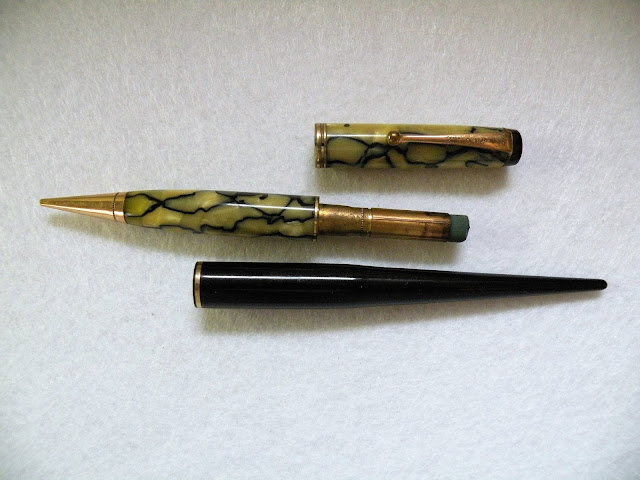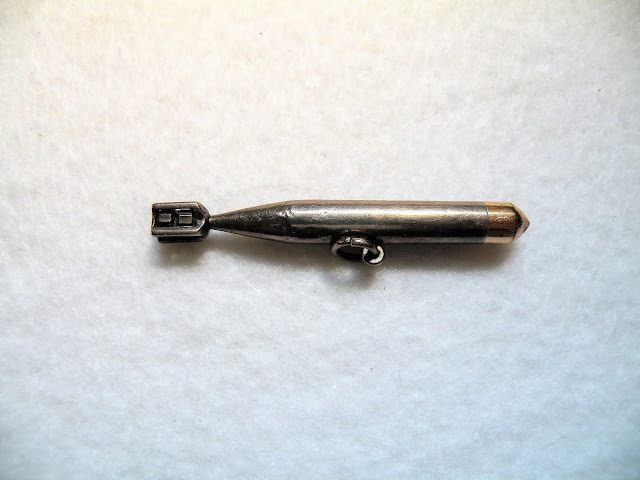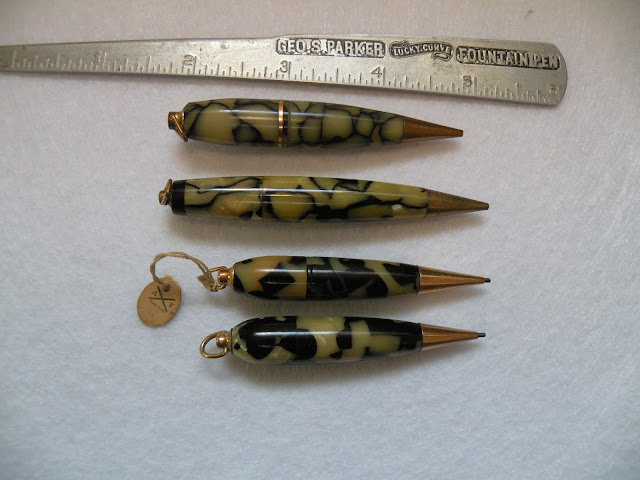Scripto and Merry Christmas!
Total Pageviews
Friday, December 24, 2021
Monday, December 20, 2021
From 1924 thru 1932 Parker produced mechanical pencils in the Duofold Flattop line (1924 thru 1929) followed by the Duofold Streamline line (1929 thru 1932). I'm showing today a small group of these pencils featuring the Parker named 'Mandarin Yellow' color. The Flattop models are pictured on the left and Streamlines on the right. The pencil 4th from the left is a transitional piece designed to help bridge the gap between old (Flattop), and new (Streamline). It had a very short life. The Parker Mandarin Yellow color began production in 1927. Other colors of both models were also produced during 1924 - 1932. For a size comparison, the Senior Flattop is 5 1/2 inches long. Matching fountain pens were also produced.
Sunday, December 12, 2021
Saturday, December 4, 2021
Saturday, November 27, 2021
Saturday, November 6, 2021
Showing is a Sampson Mordan double-ended silver cedar holder(s). The color-coded collar sliders are blue and red. Finding proper wooden refills in those colors was probably always difficult. The outer pattern is called cable twist The piece dates to the end of the 19th century Body is 4 inches in length.
Saturday, October 23, 2021
Saturday, October 9, 2021
A three-piece Victorian pencil haul from the recent Washington pen show. Top to bottom is an owl topped carpenters pencil, slider activated Mordan figural pipe, and twist activated figural acorn. All circa 1880 - 1895. For measurement perspective, the owl is 4 1/4 inches long in the extended position.
Friday, October 1, 2021
Monday, May 10, 2021
Pictured is a stockbroker pencil featuring an engine-turned sterling silver body with black and red bakelite ends. The piece is marked 935 or 93.5% silver. 925 or 92.5% silver is the accepted world standard for sterling. The English (England) established the standard many years ago. The pencil is 6 1/4 inches long and approximately 1/2 inch in diameter. Circa 1920's thru the 1930's. The high silver purity (935) suggests the country of origin to be Austria or Germany, but not England.
Saturday, April 3, 2021
Coronation mechanical pencils are not my bag man. 🙂 These two impressed me as being exceptionally stylish and well made. They found a happy home in my museum. Both are dated 1937 and honor the coronation of George VI and his wife Elizabeth. The pencils are made of sterling silver. The bottom pencil features a blue guilloche enameled body. The top piece is fully hallmarked Sampson Mordan. The lower piece has no maker markings. The enameled pencil is further marked 1937 - 1939 to represent the 2nd anniversary of the celebration.
Monday, March 8, 2021
In the 1930's Parker Pen Company produced convertible fountain pens and mechanical pencils. Here I'm showing a short jade vest pocket pencil that converts to a long-stemmed desk pencil. A second example pictured of this combination is a senior size Parker Streamline pencil in a black and pearl pattern. The last picture better shows the sizing of the various pieces (pencils 6th and 7th from the top). For sizing descreptivity (yes, my word) the box dimensions arrive at 6 by 8 inches. The converted desk pencils would be fitting into a base and holder - likely with the associated fountain pen.
Saturday, February 27, 2021
I'm showing today an Edward Todd Company figural mechanical pencil which speaks as a torpedo. Made in the United States. Circa 1885- 1900. Body material is silver - excepting the gold tip. The tip pulls away from the body revealing an attached one-stage telescopic section pencil. The compacted carry length is approximately 2 1/4 inches.
Saturday, February 20, 2021
The Conway Stuart Company of England produced quality fountain pens and mechanical pencils since the beginning of the 20th century. The company's heyday featured incredible body color combinations which spanned the 1930's thru the late 1940's. Arguably, Conway Stewart's color patterns were the most interesting of all in the writing instrument world. Showing here are two ringtop Conway Stewart pencils and an associated lead holder. Some collectors refer to this pattern as 'end of day'. The story goes that at the end of the day all the colors used in various production projects were thrown into the vat to produce this non-production mismatch type of pattern. Stories vary. The top pencil is 4 1/2 inches in length. The lower piece is 4 inches long.
Saturday, February 13, 2021
I'm showing three pencils today disguised as skeleton keys. All are of metal construction. Circa 1880 -1895. They are maker unmarked. Countries of origin could be France, England, or America. The top right piece is twist activated at the ring end. The top left piece is collar/slide driven. The bottom piece inverts into itself. None open any doors.
Monday, February 8, 2021
Saturday, January 30, 2021
Early porcupine quill bodied mechanical pencils are not uncommon. There are three or four in my stash. This one is circa 1880's. Likely made in England. The working end of the pencil is driven in and out of the body via a button controlled channel. Length is a mere 2 1/2 inches closed and 3 3/8 inches extended. The piece is not maker marked. It speaks Sampson Mordan Company to me.
Sunday, January 24, 2021
Short stubby pencils produced in the 1930's into the 1940's were and are often referred to as golf pencils. Sheaffer marketed their version as a 'Golf' pencil. The company also marketed the same pencil line as a 'Handbag' pencil. Parker named their pencils 'Vest Pocket' pencils. The company also used the black and red 'Vest Pocket's' for their bridge, card game desk sets. A few companies such as Wahl-Eversharp and Conklin produced pen/pencil combo's that featured a removable pencil section that converted into a 'golf' pencil. Many of these stubby style pencils were often brand unmarked and produced in Germany. Pictured here from top to bottom are a no-name, Parker, A.T. Cross and Sheaffer.
Saturday, January 2, 2021
Here's three Waterman Model 94 stockbroker pencils. All feature a twist cap clutch mechanism (think releasable grippers). These hold the lead in place. Positioning the pencil downward and twisting the cap loosens the grippers allowing the lead to fall down and out (by gravity). Twisting the cap the opposite way tightens the lead for writing. Reversing this procedure drops the lead back into the body and another quick twist locks up the lead for the night. The top pencil body shown here is black hard rubber and features Waterman's early 'Globe' shirt clip. The bottom two pieces are celluloid bodied with a later company clip. All three feature silver trim. Circa 1930 - 1938 All are just slightly over five inches in length.





























